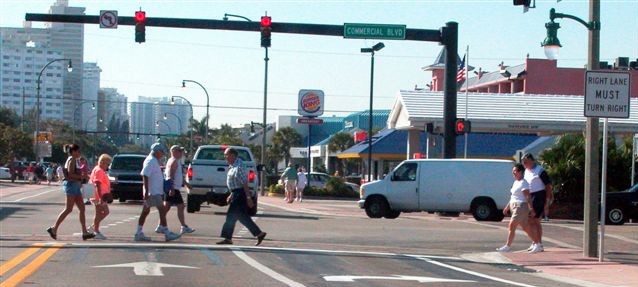(And Pedestrians Should do the Same for Drivers!)
Pedestrian crossing facilities in the USA — a.k.a. “crosswalks” — often leave a great deal to be desired regarding safety. And, whether near a crosswalk or not, drivers need to be continually alert that the unexpected is quite likely to happen.

Despite using a marked crossing, these pedestrians are not very well protected. At most light-controlled hubs in the USA, traffic can flow (and turn) from the roads that run parallel to the pedestrians. Therefore, great caution is needed from walkers, and great vigilance is required from drivers. For a more detailed explanation of the potential problems, see “For Visiting Drivers” below.
Note also that the street name, “Commercial Blvd,” on the traffic-light gantry, applies to the road running left to right, not the one directly ahead.
All photographs on this page are courtesy of the AAA Foundation
 Joggers are always a potential hazard, whether you are in Manhattan or what appears to be the middle of nowhere.
Joggers are always a potential hazard, whether you are in Manhattan or what appears to be the middle of nowhere.
The ones wearing headphones, like this brave guy (right), can’t hear your car coming, either!
(For those of you who remember the spoof movie — Death Race 2,000 — you do not get extra points for joggers, with or without headphones! So please treat them with great caution.)
Due to hand-held cell phones, driver distraction has been much in the news recently, but of course, the distraction needn’t be limited just to drivers.
Never mind suicide; some of these people are unwittingly capable of committing mobile homicide. If you see someone near the curb chatting on the phone, be ready for them to step out in front of you.
Notes For Drivers Visiting The USA
(and for any visitors who want to “go for a walk!”)
Most pedestrian crossings (known as “crosswalks”) in the USA are at road junctions (“intersections”) and are often — to some extent, at least — controlled by light signals. But even at the best of these, where “Walk” and “Don’t Walk” (or equivalent) signs are in operation, some vehicles may still be moving, and thus, there is still a potential danger.
The rules, generally, are as follows:
1. Pedestrians must only cross at marked crosswalks or intersections; anything else is called “jaywalking.”
2. If there is no “Walk” — “Don’t Walk” signs at an intersection, pedestrians should only cross when the ordinary traffic lights are on green for roads parallel to the direction they wish to travel. It is then up to the driver of any vehicle turning into that street to give way (“yield”) to pedestrians crossing the road.
3. It is frequently the case that drivers who intend to turn right at traffic lights are allowed to do so even when faced with a red “stop” light. This is permitted because they will not be crossing other moving vehicles’ paths. (But crashes between cars turning “right on red” and vehicles coming from the opposite direction and turning left on a green light are commonplace. The driver turning right is meant to yield, but many disregard this rule.)
The problem for pedestrians, however, is that although vehicles that are going “right on red” are meant to stop at the stop line until the driver can see it’s safe, and only then drive forwards and turn, this is probably the most abused law on America’s roads. Watch at any junction; it won’t be long before you see drivers fail to stop when going “right on red.” Even when their view of the center of the crosswalk is blocked by vehicles that have stopped in the left-hand lane(s), these idiots will drive straight over the stop line and straight over the pedestrian “crosswalk,” so if ever you are using one of these crossings be immensely careful in looking for these ten-a-penny lunatics.
In connection with traffic lights (“traffic signals”), visiting drivers should note that while the general rule is that you may “turn right on red” unless signs dictate otherwise, there are some places where the exact opposite is the case — you may NOT do so unless signs specify that you can. Check on the individual state(s) you will be visiting. Please visit our page: Road Safety Links for Each U.S. State.
4. even though crosswalks away from traffic lights are uncommon and — frequently — very poorly marked if you hit a pedestrian, the penalties can be extremely severe (as in long-term imprisonment), so be extra vigilant.
Some states paint the entire crosswalk a reasonably bright color — in Massachusetts, for example, they are green — but there may be pairs of heavily faded white lines in other states.
5. On car parks (“parking lots”), it is generally expected that pedestrians have the right of way — either that or American drivers, in this context, are just a lot more courteous than their European counterparts — but do be very careful on car parks:
a) watch for pedestrians who, from experience, assume that you will stop to let them cross in front of you, and
b) also watch for frequent “Stop” signs (often without any white lines painted on the ground). Even if the car park is vast and empty, and you can see nothing coming for miles around, these signs ARE compulsory, and failing to stop could easily land you in court.
Have a great visit… and a safe one!

